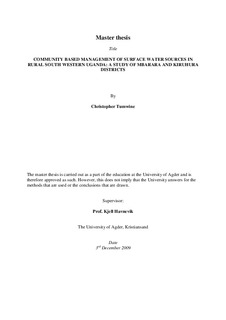| dc.description.abstract | Introduction
When managed appropriately, water is a precious natural resource, vital for life, development
and the environment. Community based management (CBM) is the style of management the
Ugandan Ministry of Water and Environment recommends for most water facilities
constructed in rural areas. Although community based management of water facilities is
recommended, it is largely for government constructed facilities and many people in the two
districts of Kiruhura and Mbarara communally use privately constructed surface water
sources. The objectives of this study therefore were to establish; What rules and practices are
important in managing government constructed surface water sources in the districts of
Mbarara and Kiruhura?; What rules and practices are important in managing communal
privately constructed surface water sources in the districts of Mbarara and Kiruhura?; How do
rules and practices that are important in managing government constructed sources compare
with those that are important in managing privately constructed sources?; What challenges are
faced by communities in the districts of Mbarara and Kiruhura in managing surface water
sources?
Methods
In order to achieve the above objectives un-structured interviews with 50 overseers of surface
water sources, in-depth interviews with 2 district water officers, and 2 focus group discussions
with surface water source users were conducted to gather data.
Results
With government constructed surface water sources, the practices included holding meetings
to discuss the use of water sources, monitoring the use of the sources, establishment of water
user committees to monitor the use of water sources. The study established that rules which
guide water users could be divided into: daily maintenance rules/dos and don’ts (washing of
clothes around the source should be done at a considerable distance from the source, sending
very young children to collect water is not allowed, washing vehicles in or very near the
sources is not allowed, animals are not allowed to drink directly from the source, bathing and
playing in the water source is not allowed, drawing water for sale is not allowed, permission
must be sought before drawing water for livestock, stepping into the water is not allowed),
periodical maintenance rules and rules relating to land use patterns around the water sources.
The practices associated with managing privately constructed surface water sources included
to a limited extent holding meetings to discuss the use of water sources, establishment of
water user committees to monitor the use of water sources and to a large extent informal
monitoring of the use of water sources. The study established that rules which guide water
users could also be divided into: daily maintenance rules/dos and don’ts (washing of clothes
around the source should be done at a considerable distance from the source, sending very
young children to collect water is not allowed, washing vehicles in or very near the sources is
not allowed, animals are not allowed to drink directly from the source, bathing and playing in
the water source is not allowed, drawing water for sale is not allowed, permission must be
sought before drawing water for livestock, stepping into the water is not allowed), periodical
maintenance rules and rules relating to land use patterns around the water sources.
A comparison of the two types of surface water sources showed that government constructed
water sources generally are subjected to more misuse than privately constructed but
communally used water sources. With privately constructed sources, the possibility of
iii
banning certain water users from accessing water sources remains very real and partly
explains the better water use practices that they enjoyed over the government constructed
sources.
Challenges faced by communities in managing surface water sources included drying up of
the sources, difficulty of rallying water users to participate in maintaining sources,
dysfunctional water pumping technologies. Other challenges emanated from conflicting land
uses, the levels of water quality, and use of water sources stealthily at night.
Conclusion
Currently, an effective institutional framework governing the use of surface water sources in
Mbarara and Kiruhura does not exist. This is mainly because there is a gap between the rules
and the practices on the ground. Despite this, the potential for the development of effective
institutions to govern the use of surface water sources exists. The rules and the potential to
generate more “current” rules to respond to changing situations exist and now what needs to
be changed are the daily practices in order for these to match with the existing rules. | en |
